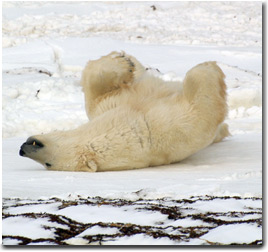
LOST PLACE  |
APRIL 2009 – NO. 32 |
 |
Dispatch from the American Arctic: A Sense of Despair
It is March 17 and 45 degrees below zero in Deadhorse, Alaska, on the edge of the Arctic Ocean. At this temperature, trucks thump down the road with tires stiffened out of round. Ice fog hangs in the air, a mist of tiny suspended crystals. Iced-in sky and snow-covered ground meld together.
It is the final month of the fourth International Polar Year. The first International Polar Year was in 1882, the second in 1932, and the third in 1957. Each had its headlines — 13 expeditions to the Arctic in 1882, airplanes in 1932, rockets and radar in 1957. The fourth International Polar Year has seen impressive activity, but the news from the far north is not so great. In the Arctic Report Card, prepared by an international team of scientists, a color-coded grading system gives the Arctic reds and yellows — red for atmosphere and sea ice, yellow for biology and ocean and land. If this were my son's report card, I would be upset. F's and D's are just not good enough. What the heck is going on, and how can we turn those reds and yellows into greens?
I telephone Tom Smith, a long-term acquaintance and bear expert. For the past nine years, Tom and his crews have focused video cameras on polar bear dens, waiting for moms and cubs to emerge. This is not as easy as pointing the camera and pushing "record." It involves finding the dens, which, from the outside, are indistinguishable from snow drifts. It involves devising a system that records for weeks on end, subject to wind and battery-eating temperatures and arctic foxes that urinate on camera lenses. In the end, it can produce disappointment: a den that turns out to be nothing but a snow bank after all or a camera that fails just before a bear emerges. But sometimes it yields great footage: She comes out for short intervals, always during daylight, a patient mother filling her empty stomach with frozen tundra grasses, staying close to the den's opening for a week, biding time while her cubs grow strong enough for the nomadic life ahead. Then the mother and her cubs head north, out onto the ice.
"So what's the deal?" I ask Tom. "Why the "yellow" for biology?"
Something like 20,000 bears wander the Arctic. Their numbers increased in Alaska after the sport hunt was outlawed in 1972. But the sea ice, their primary habitat, the place where they hunt seals, is disappearing. Certain computer models predict ice free summers within decades. Boats could soon sail to the North Pole. Satellite photographs — not models, not speculations — show a shrunken summertime ice pack. In the past few years, a patch of pristine polar bear habitat larger than Alaska has disappeared. It is as if someone just built a parking lot three times the size of Texas on top of your favorite slice of wilderness.
The bears, it is sometimes said, can move ashore. They evolved from grizzlies 250,000 years ago, so they can summer on land, as now occurs around Hudson Bay. But in fact evolution is a one way street. Polar bears stranded on land slowly starve, pacing around in what has been called a state of walking hibernation. Adults fail to put on the weight needed to get through winter. Litters are smaller. Cub growth slows. When bears attempt long swims toward an ice pack that they know is out there, somewhere beyond the horizon, they drown.
What can we do? "We're learning more about how the bears will adapt to life on land," Tom says. They will still have the sea ice in winter, so maybe they will be okay. The bears stranded ashore at Hudson Bay are sometimes seen eating berries and roots. "But you can't grow as big as a polar bear on berries and roots," he says. He does not believe that humans will reduce carbon emissions in a way that will reverse climate change. The Arctic he grew up with is not going to be the Arctic with which he grows old.
The first International Polar Year was a time of celebration, of discovery. There were hardships in the late 19th century, to be sure. Notably, there was the Greely Expedition, sent to gather weather data, that ended after three long years when seven starving survivors were plucked from the ice. But with hardships there was enthusiasm and hope, a sense of grand adventure and real purpose, of endurance and effort.
Today, the enthusiasm remains, and a feeling of adventure. But with the color-coded grade for arctic biology far more likely to go from yellow to red rather than to green, and with the red for ice probably frozen in place, today's sense of purpose seems shrouded by a sense of despair that, while different than the sort of despair experienced by Greely and his men, is nevertheless absolutely profound. What is needed now, for all of us, is the kind of ingenuity that allowed nineteenth century explorers to survive on the sea ice, but applied on a grand scale. We need an ingenuity that will slow the pace of warming and eventually reverse the warming trends. And with that ingenuity, we need the same sort of fortitude that kept Greely alive on the ice, waiting for an uncertain rescue. But our wait will be longer than his. Our wait will stretch beyond our life times. The wait for a return to normal ice conditions will require a fortitude that crosses generations. With luck, the Arctic of our childrens' children may be the Arctic that we ourselves knew in our youths.
Photo courtesy of Tom Smith.
